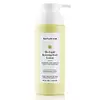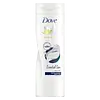What's inside
What's inside
 Key Ingredients
Key Ingredients

 Benefits
Benefits

 Concerns
Concerns

 Ingredients Side-by-side
Ingredients Side-by-side

Water
Skin ConditioningCarthamus Tinctorius Seed Oil
MaskingCetyl Alcohol
EmollientGlycerin
HumectantCaprylic/Capric Triglyceride
MaskingButyrospermum Parkii Butter
Skin ConditioningDimethicone
EmollientC10-18 Triglycerides
EmollientMoringa Oleifera Seed Oil
EmollientNiacinamide
SmoothingRosa Canina Fruit Oil
EmollientPanthenol
Skin ConditioningSodium PCA
HumectantSodium Stearoyl Glutamate
CleansingSqualane
EmollientVaccinium Myrtillus Fruit Extract
Skin ConditioningSaccharum Officinarum Extract
MoisturisingRiboflavin
Cosmetic ColorantTocopherol
AntioxidantCitrus Aurantium Dulcis Fruit Extract
MaskingCitrus Limon Fruit Extract
MaskingSodium Glycolate
BufferingCamellia Sinensis Leaf Extract
AntimicrobialSpilanthes Acmella Flower Extract
Skin ConditioningSodium Formate
BufferingAcer Saccharum Extract
Skin ConditioningSodium Hyaluronate
HumectantCetearyl Olivate
Sorbitan Olivate
EmulsifyingPhenoxyethanol
PreservativeCarbomer
Emulsion StabilisingTocopheryl Acetate
AntioxidantEthylhexylglycerin
Skin ConditioningSodium Hydroxide
BufferingTetrasodium Glutamate Diacetate
Citric Acid
BufferingPotassium Sorbate
PreservativeSodium Benzoate
MaskingWater, Carthamus Tinctorius Seed Oil, Cetyl Alcohol, Glycerin, Caprylic/Capric Triglyceride, Butyrospermum Parkii Butter, Dimethicone, C10-18 Triglycerides, Moringa Oleifera Seed Oil, Niacinamide, Rosa Canina Fruit Oil, Panthenol, Sodium PCA, Sodium Stearoyl Glutamate, Squalane, Vaccinium Myrtillus Fruit Extract, Saccharum Officinarum Extract, Riboflavin, Tocopherol, Citrus Aurantium Dulcis Fruit Extract, Citrus Limon Fruit Extract, Sodium Glycolate, Camellia Sinensis Leaf Extract, Spilanthes Acmella Flower Extract, Sodium Formate, Acer Saccharum Extract, Sodium Hyaluronate, Cetearyl Olivate, Sorbitan Olivate, Phenoxyethanol, Carbomer, Tocopheryl Acetate, Ethylhexylglycerin, Sodium Hydroxide, Tetrasodium Glutamate Diacetate, Citric Acid, Potassium Sorbate, Sodium Benzoate
Water
Skin ConditioningGlycerin
HumectantCyclopentasiloxane
EmollientEthylhexyl Cocoate
EmollientParaffinum Liquidum
EmollientCetyl PEG/PPG-10/1 Dimethicone
EmulsifyingCaprylyl Glycol
EmollientDisodium Phosphate
BufferingParfum
MaskingPhenoxyethanol
PreservativeParaffin
PerfumingCera Microcristallina
Emulsion StabilisingStearic Acid
CleansingHelianthus Annuus Seed Oil
EmollientTriolein
Skin ConditioningTocopherol
AntioxidantAlpha-Isomethyl Ionone
PerfumingBenzyl Alcohol
PerfumingCitronellol
PerfumingCoumarin
PerfumingGeraniol
PerfumingHexyl Cinnamal
PerfumingLimonene
PerfumingLinalool
PerfumingWater, Glycerin, Cyclopentasiloxane, Ethylhexyl Cocoate, Paraffinum Liquidum, Cetyl PEG/PPG-10/1 Dimethicone, Caprylyl Glycol, Disodium Phosphate, Parfum, Phenoxyethanol, Paraffin, Cera Microcristallina, Stearic Acid, Helianthus Annuus Seed Oil, Triolein, Tocopherol, Alpha-Isomethyl Ionone, Benzyl Alcohol, Citronellol, Coumarin, Geraniol, Hexyl Cinnamal, Limonene, Linalool
 Reviews
Reviews

Ingredients Explained
These ingredients are found in both products.
Ingredients higher up in an ingredient list are typically present in a larger amount.
Glycerin is already naturally found in your skin. It helps moisturize and protect your skin.
A study from 2016 found glycerin to be more effective as a humectant than AHAs and hyaluronic acid.
As a humectant, it helps the skin stay hydrated by pulling moisture to your skin. The low molecular weight of glycerin allows it to pull moisture into the deeper layers of your skin.
Hydrated skin improves your skin barrier; Your skin barrier helps protect against irritants and bacteria.
Glycerin has also been found to have antimicrobial and antiviral properties. Due to these properties, glycerin is often used in wound and burn treatments.
In cosmetics, glycerin is usually derived from plants such as soybean or palm. However, it can also be sourced from animals, such as tallow or animal fat.
This ingredient is organic, colorless, odorless, and non-toxic.
Glycerin is the name for this ingredient in American English. British English uses Glycerol/Glycerine.
Learn more about GlycerinPhenoxyethanol is a preservative that has germicide, antimicrobial, and aromatic properties. Studies show that phenoxyethanol can prevent microbial growth. By itself, it has a scent that is similar to that of a rose.
It's often used in formulations along with Caprylyl Glycol to preserve the shelf life of products.
Tocopherol (also known as Vitamin E) is a common antioxidant used to help protect the skin from free-radicals and strengthen the skin barrier. It's also fat soluble - this means our skin is great at absorbing it.
Vitamin E also helps keep your natural skin lipids healthy. Your lipid skin barrier naturally consists of lipids, ceramides, and fatty acids. Vitamin E offers extra protection for your skin’s lipid barrier, keeping your skin healthy and nourished.
Another benefit is a bit of UV protection. Vitamin E helps reduce the damage caused by UVB rays. (It should not replace your sunscreen). Combining it with Vitamin C can decrease sunburned cells and hyperpigmentation after UV exposure.
You might have noticed Vitamin E + C often paired together. This is because it is great at stabilizing Vitamin C. Using the two together helps increase the effectiveness of both ingredients.
There are often claims that Vitamin E can reduce/prevent scarring, but these claims haven't been confirmed by scientific research.
Learn more about TocopherolWater. It's the most common cosmetic ingredient of all. You'll usually see it at the top of ingredient lists, meaning that it makes up the largest part of the product.
So why is it so popular? Water most often acts as a solvent - this means that it helps dissolve other ingredients into the formulation.
You'll also recognize water as that liquid we all need to stay alive. If you see this, drink a glass of water. Stay hydrated!
Learn more about Water